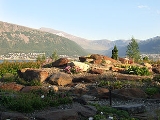
Arctic-alpine botanic garden
Encyclopedia

Botanical garden
A botanical garden The terms botanic and botanical, and garden or gardens are used more-or-less interchangeably, although the word botanic is generally reserved for the earlier, more traditional gardens. is a well-tended area displaying a wide range of plants labelled with their botanical names...
. It is located in Tromsø
Tromsø
Tromsø is a city and municipality in Troms county, Norway. The administrative centre of the municipality is the city of Tromsø.Tromsø city is the ninth largest urban area in Norway by population, and the seventh largest city in Norway by population...
, Norway
Norway
Norway , officially the Kingdom of Norway, is a Nordic unitary constitutional monarchy whose territory comprises the western portion of the Scandinavian Peninsula, Jan Mayen, and the Arctic archipelago of Svalbard and Bouvet Island. Norway has a total area of and a population of about 4.9 million...
, and is run by the Tromsø University Museum
Tromsø University Museum
Tromsø University Museum is the oldest scientific institution in North-Norway. It was established in 1872 and incorporated in the University of Tromsø in 1976...
. It opened in 1994, and is open from late May to early October. The garden displays Arctic and alpine plants from all over the northern hemisphere
Northern Hemisphere
The Northern Hemisphere is the half of a planet that is north of its equator—the word hemisphere literally means “half sphere”. It is also that half of the celestial sphere north of the celestial equator...
. Entrance is free of charge.
The garden is located to the southeast of the University of Tromsø Campus, commanding a view of the mountains to the east and south. The location, corresponding to the north coast of Alaska
Alaska
Alaska is the largest state in the United States by area. It is situated in the northwest extremity of the North American continent, with Canada to the east, the Arctic Ocean to the north, and the Pacific Ocean to the west and south, with Russia further west across the Bering Strait...
, invites thought of an extreme Arctic
Arctic
The Arctic is a region located at the northern-most part of the Earth. The Arctic consists of the Arctic Ocean and parts of Canada, Russia, Greenland, the United States, Norway, Sweden, Finland, and Iceland. The Arctic region consists of a vast, ice-covered ocean, surrounded by treeless permafrost...
climate. However, a branch of the Gulf Stream
Gulf Stream
The Gulf Stream, together with its northern extension towards Europe, the North Atlantic Drift, is a powerful, warm, and swift Atlantic ocean current that originates at the tip of Florida, and follows the eastern coastlines of the United States and Newfoundland before crossing the Atlantic Ocean...
sweeping up the coast of North Norway provides a moderating influence, and the climate of Tromsø is one of relatively mild winters (January average -4.4 °C) and cool summers (July average 11.7 °C (53.1 °F)).
From May 15 until July 27, the sun is continuously above the horizon in Tromsø. The two months of midnight sun
Midnight sun
The midnight sun is a natural phenomenon occurring in summer months at latitudes north and nearby to the south of the Arctic Circle, and south and nearby to the north of the Antarctic Circle where the sun remains visible at the local midnight. Given fair weather, the sun is visible for a continuous...
provide some compensation to the plants for the short growing season and the low temperatures. In the months of May, June and July the theoretically possible number of hours of sunshine is 623, 720 and 695, respectively. The average hours of actual sunshine is about 200 for each of these months. From November 21 until January 17 the sun never rises. Snow generally covers the ground from October or November on, and will accumulate until the beginning of April. Snow then gradually melts and the ground will usually be bare around mid May at sea level, while lingering on far into the summer at higher altitudes. The season in the Botanic Garden is usually from end of May until mid October.
Special Collections:
Rhododendron (eg. R. Lapponicum), Meconopsis
Meconopsis
Meconopsis is a genus of flowering plants in the family Papaveraceae. The species have attractive flowers and have two distinct ranges. A single species, Meconopsis cambrica , is indigenous to England, Wales, Ireland, and the fringes of Western Europe. The other 40 or so species are found in the...
, Aster, Polemonium
Polemonium
Polemonium, commonly called Jacob's ladder, is a genus of about 30 species of flowering plants in the family Polemoniaceae, native to cool temperate to arctic regions of the Northern Hemisphere and also in the southern Andes in South America...
, Erigeron
Erigeron
Erigeron is a genus of about 390 species of flowering plants in the family Asteraceae. The genus has a cosmopolitan distribution with the highest species diversity in North America, where 173 species occur....
, Codonopsis
Codonopsis
Codonopsis is a genus of flowering plant within the family Campanulaceae. It is allied to Campanumoea and Leptocodon, and some authors suggest that Codonopsis should include these genera...
, Rose Cultivars, Allium
Allium
Allium is a monocot genus of flowering plants, informally referred to as the onion genus. The generic name Allium is the Latin word for garlic....
, Saxifraga, Silene
Silene
Silene is a genus of flowering plants in the family Caryophyllaceae. Common names include campion and catchfly....
, Tellima, Heu

